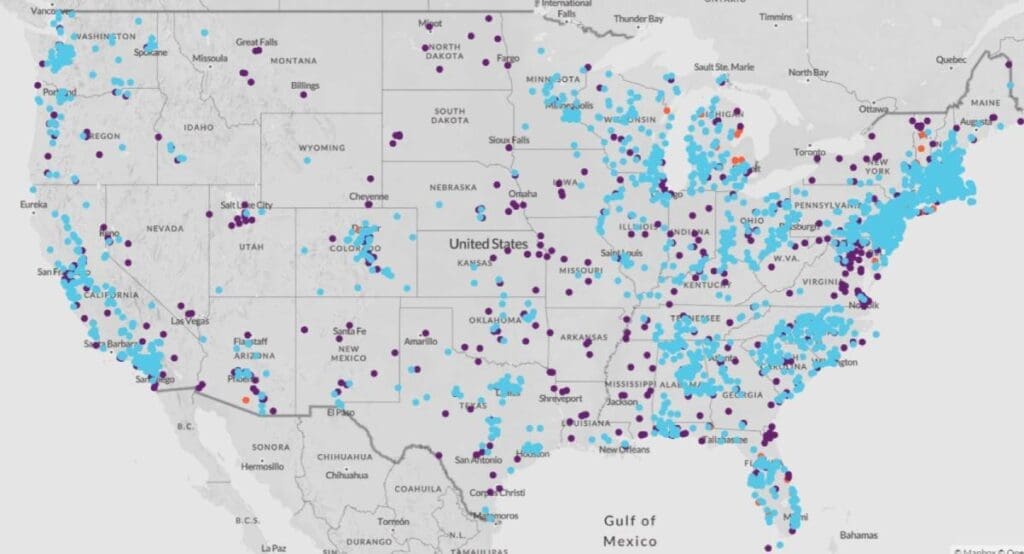PFAS

Perfluoroalkyl and polyfluoroalkyl substances (PFAS) are a diverse group of thousands of chemicals, widely known as “forever chemicals”, used in hundreds of types of products. The four major sources of PFAS in groundwater are fire training/fire response sites, industrial sites, landfills, and wastewater treatment plants/biosolids. Additionally, during its actual production and use, PFAS can migrate into the soil, water, and air.
PFAS are not naturally occurring; they are manmade compounds that have been used widely over the past several decades in industrial applications and consumer products since many PFAS have repellant and surfactant properties. Most PFAS do not break down, so they remain in the environment – which lends to how they earned the forever chemical name.
Major sources of PFAS contamination in the United States include:
- Industrial facilities that produce process PFAS and the surrounding areas,
- Facilities that use PFAS chemicals or products in manufacturing or other activities
- Areas where Fire Fighting Foams are stored, used, or released
- Waste management facilities, such as landfills
- Wastewater treatment residuals and areas of biosolids production and application, with more significant impacts associated with industrial wastewater discharges.
- Commercial inputs like schools, hotels, and box stores that can discharge high concentrations, linked to commercial cleaning activities like floor treatments
PFAS are linked to negative health impacts in humans, including cancer. PFAS have long half-lives and bioaccumulate in the environment and human body. In 2024, the Environmental Protection Agency concluded that “the science is clear that exposure to certain PFAS over a long period of time can cause cancer and other illnesses”.
PFOS
Perfluorooctane Sulfonate (PFOS) is a member of the PFAS group. Some of the human health concerns about exposure to PFOS and other PFAS stem from their resistance to hydrolysis, photolysis, metabolism, and microbial degradation in the environment and in the human body.
While most PFOS production in the United States was voluntarily phased out by its primary manufacturer (3M) between 2000 and 2002, the prevalence of PFOS in the environment remains persistent because the chemical is resistant to environmental degradation. PFOS has been detected in surface water and sediment downstream of production facilities and in wastewater treatment plant effluent, sewage sludge and landfill leachate at a number of cities in the United States.
AFFF
Aqueous Film-Forming Foam (AFFF) is a PFOS-based type of foam used by fire departments to extinguish liquid-based fires, such as those caused by gasoline, oil, or other flammable liquids. AFFF is often used in fire suppression systems on ships and at shore facilities, in fire fighting vehicles, and at fire training facilities.
Some firefighting foams designed for extinguishing flammable liquid hydrocarbon fires and vapor suppression may contain fluorine. These foams can be a major source of local PFAS release to the environment, as demonstrated by the image below”

AFFF is highly concerning because it contains PFAS (per- and polyfluoroalkyl substances). chemicals known to negatively impact human health and do not easily break down in the environment, waterways, wildlife, or human bodies.
AFFF is the leading cause of PFAS contamination in drinking water. In addition, in 2024 a study found firefighting foam exposure was directly linked to testicular cancer diagnoses.
The majority of states across the country are taking action to limit or ban the use of PFAS and AFFF, including, Minnesota, New York, North Carolina, Nevada, Rhode Island, Virginia, Washington, and Wisconsin because of its ability to contaminate precious groundwater resources. In 2020, The National Defense Authorization Act banned the use of AFFF foam by the military.
While enacting new legislation to protect the watersheds is a step in the right direction, the damage to the environment has already been extensive and devastating. The below map, maintained by the Environmental Working Group, shows water contamination in the contiguous 48 states on a massive scale:

PFAS Water Contamination Lawsuits Filed Nationwide
Thousands of PFAS lawsuits have been filed on behalf of citizens who have suffered severe health issues as a result of either:
1. Living as a resident in an area with contaminated groundwater from AFFF, or
2. Employed as a Fire Fighter and exposed to PFAS as an occupational hazard through AFFF,
3. Military personnel charged with the task of storage and/or removal of PFAS/AFFF.
The most common injuries among affected clients are:
- Kidney Cancer
- Liver Cancer
- Testicular Cancer
- Thyroid Cancer
- Thyroid Disease
- Ulcerative Colitis
Free PFAS/AFFF Lawsuit Case Consultation
Please fill out our webform or call us at 202-792-7927. Call today if you or a loved one have been exposed to PFAS/AFFF and developed the above injuries. At this time, Nigh Goldenberg Raso & Vaughn are still accepting new PFAS/AFFF cases and filing PFAS/AFFF lawsuits. Various statutes of limitations could apply to any PFAS/AFFF lawsuit – don’t delay.
PFAS Lawsuits Consolidated into MDL in South Carolina Federal Court
Case Title: IN RE: Aqueous Film-Forming Foams Products Liability Litigation
Judge
MDL Number: 2:18-mn-2873-RMG
Court: United States District Court for the District of South Carolina, Charleston Division
This multidistrict litigation (MDL) involves claims related to aqueous film-forming foams (AFFF), a type of firefighting foam suspected to have caused widespread environmental contamination and health issues. The litigation consolidates numerous lawsuits against manufacturers of AFFF products.







